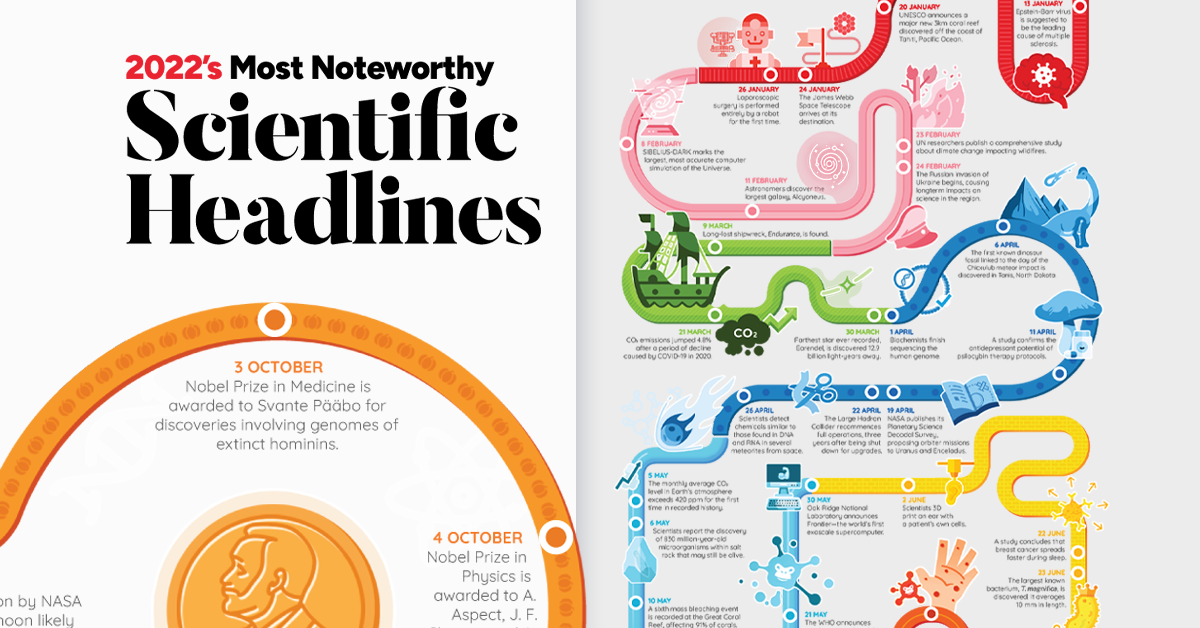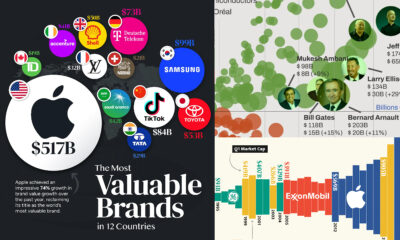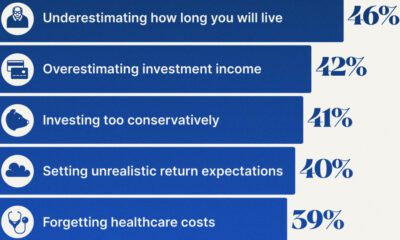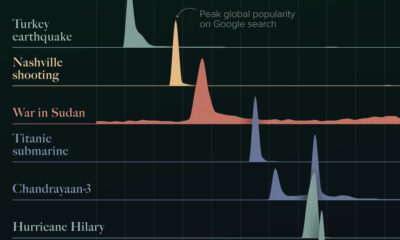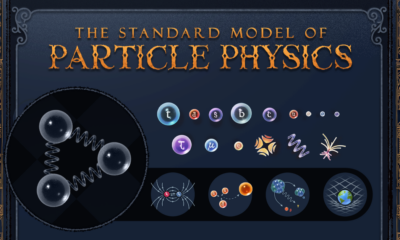Technology
Timeline: The Most Important Science Headlines of 2022

Scientific discoveries and technological innovation play a vital role in addressing many of the challenges and crises that we face every year.
The last year may have come and gone quickly, but scientists and researchers have worked painstakingly hard to advance our knowledge within a number of disciplines, industries, and projects around the world.
Over the course of 2022, it’s easy to lose track of all the amazing stories in science and technology.
At a Glance: Major Scientific Headlines of 2022
Below we dive a little deeper into some of the most interesting headlines, while providing links in case you want to explore these developments further.
The James Webb Space Telescope Arrives at its Destination
What happened: A new space telescope brings promise of exciting findings and beautiful images from the final frontier. This telescope builds on the legacy of its predecessor, the Hubble Space Telescope, which launched over 30 years ago.
Why it matters: The James Webb Space Telescope is our latest state-of-the-art “window” into deep space. With more access to the infrared spectrum, new images, measurements, and observations of outer space will become available.
» To learn more, read this article from The Planetary Society, or watch this video from the Wall Street Journal.
Complete: The Human Genome
What happened: Scientists finish sequencing the human genome.
Why it matters: A complete human genome allows researchers to better understand the genetic basis of human traits and diseases. New therapies and treatments are likely to arise from this development.
» To learn more, watch this video by Two Minute Papers, or read this article from NIH
Monkeypox Breaks Out
What happened: A higher volume of cases of the monkeypox virus was reported in non-endemic countries.
Why it matters: Trailing in the shadow of a global pandemic, researchers are keeping a closer eye on how diseases spread. The sudden spike of multinational incidences of monkeypox raises questions about disease evolution and prevention.
» To learn more, read this article by the New York Times.
A Perfectly Preserved Woolly Mammoth
What happened: Gold miners unearth a 35,000 year old, well-preserved baby woolly mammoth in the Yukon tundra.
Why it matters: The mammoth, named Nun cho ga by the Tr’ondëk Hwëch’in First Nation, is the most complete specimen discovered in North America to date. Each new discovery allows paleontologists to broaden our knowledge of biodiversity and how life changes over time.
» To learn more, read this article from Smithsonian Magazine
The Rise of AI Art
What happened: Access to new computer programs, such as DALL-E and Midjourney, give members of the general public the ability to create images from text-prompts.
Why it matters: Widespread access to generative AI tools fuels inspiration—and controversy. Concern for artist rights and copyright violations grow as these programs potentially threaten to diminish creative labor.
» To learn more, read this article by MyModernMet, or watch this video by Cleo Abram.
Dead Organs Get a Second Chance
What happened: Researchers create a perfusion system that can revitalize organs after cellular death. Using a special mixture of blood and nutrients, organs of a dead pig can be sustained after death—and in some cases, even promote cellular repair.
Why it matters: This discovery could potentially lead to a greater shelf-life and supply of organs for transplant.
» To learn more, read this article by Scientific American, or this article from the New York Times
DART Delivers A Cosmic Nudge
What happened: NASA crashes a spacecraft into an asteroid just to see how much it would move. Dimorphos, a moonlet orbiting a larger asteroid called Didymos 6.8 million miles (11 million km) from Earth, is struck by the DART (Double Asteroid Redirection Test) spacecraft. NASA estimates that as much as 22 million pounds (10 million kg) was ejected after the impact.
Why it matters: Earth is constantly at risk of being struck by stray asteroids. Developing reliable methods of deflecting near-Earth objects could save us from meeting the same fate as the dinosaurs.
» To learn more, watch this video by Real Engineering, or read this article from Space.com
Falling Sperm Counts
What happened: A scientific review suggests human sperm counts are decreasing—up to 62% over the past 50 years.
Why it matters: A lower sperm count makes it more difficult to conceive naturally. Concerns about global declining male health also arise because sperm count is a marker for overall health. Researchers look to extraneous stressors that may be affecting this trend, such as diet, environment, or other means.
» To learn more, check out this article from the Guardian.
Finding Ancient DNA
What happened: Two million-year-old DNA is found in Greenland.
Why it matters: DNA is a record of biodiversity. Apart from showing that a desolate Arctic landscape was once teeming with life, ancient DNA gives hints about our advancement to modern life and how biodiversity evolves over time.
» To learn more, read this article from National Geographic
Fusing Energy
What happened: The U.S. Department of Energy reports achieving net energy gain for the first time in the development of nuclear fusion.
Why it matters: Fusion is often seen as the Holy Grail of safe clean energy, and this latest milestone brings researchers one step closer to harnessing nuclear fusion to power the world.
» To learn more, view our infographic on fusion, or read this article from BBC
Science in the New Year
The future of scientific research looks bright. Researchers and scientists are continuing to push the boundaries of what we know and understand about the world around us.
For 2023, some disciplines are likely to continue to dominate headlines:
- Advancement in space continues with projects like the James Webb Space Telescope and SETI COSMIC’s hunt for life beyond Earth
- Climate action may become more demanding as recovery and prevention from extreme weather events continue into the new year
- Generative AI tools such as DALL-e and ChatGPT were opened to public use in 2022, and ignited widespread interest in the potential of artificial intelligence
- Even amidst the lingering shadow of COVID-19, new therapeutics should advance medicine into new territories
Where science is going remains to be seen, but this past year instills faith that 2023 will be filled with even more progress.
Technology
Visualizing AI Patents by Country
See which countries have been granted the most AI patents each year, from 2012 to 2022.

Visualizing AI Patents by Country
This was originally posted on our Voronoi app. Download the app for free on iOS or Android and discover incredible data-driven charts from a variety of trusted sources.
This infographic shows the number of AI-related patents granted each year from 2010 to 2022 (latest data available). These figures come from the Center for Security and Emerging Technology (CSET), accessed via Stanford University’s 2024 AI Index Report.
From this data, we can see that China first overtook the U.S. in 2013. Since then, the country has seen enormous growth in the number of AI patents granted each year.
| Year | China | EU and UK | U.S. | RoW | Global Total |
|---|---|---|---|---|---|
| 2010 | 307 | 137 | 984 | 571 | 1,999 |
| 2011 | 516 | 129 | 980 | 581 | 2,206 |
| 2012 | 926 | 112 | 950 | 660 | 2,648 |
| 2013 | 1,035 | 91 | 970 | 627 | 2,723 |
| 2014 | 1,278 | 97 | 1,078 | 667 | 3,120 |
| 2015 | 1,721 | 110 | 1,135 | 539 | 3,505 |
| 2016 | 1,621 | 128 | 1,298 | 714 | 3,761 |
| 2017 | 2,428 | 144 | 1,489 | 1,075 | 5,136 |
| 2018 | 4,741 | 155 | 1,674 | 1,574 | 8,144 |
| 2019 | 9,530 | 322 | 3,211 | 2,720 | 15,783 |
| 2020 | 13,071 | 406 | 5,441 | 4,455 | 23,373 |
| 2021 | 21,907 | 623 | 8,219 | 7,519 | 38,268 |
| 2022 | 35,315 | 1,173 | 12,077 | 13,699 | 62,264 |
In 2022, China was granted more patents than every other country combined.
While this suggests that the country is very active in researching the field of artificial intelligence, it doesn’t necessarily mean that China is the farthest in terms of capability.
Key Facts About AI Patents
According to CSET, AI patents relate to mathematical relationships and algorithms, which are considered abstract ideas under patent law. They can also have different meaning, depending on where they are filed.
In the U.S., AI patenting is concentrated amongst large companies including IBM, Microsoft, and Google. On the other hand, AI patenting in China is more distributed across government organizations, universities, and tech firms (e.g. Tencent).
In terms of focus area, China’s patents are typically related to computer vision, a field of AI that enables computers and systems to interpret visual data and inputs. Meanwhile America’s efforts are more evenly distributed across research fields.
Learn More About AI From Visual Capitalist
If you want to see more data visualizations on artificial intelligence, check out this graphic that shows which job departments will be impacted by AI the most.
-

 Mining1 week ago
Mining1 week agoGold vs. S&P 500: Which Has Grown More Over Five Years?
-

 Markets2 weeks ago
Markets2 weeks agoRanked: The Most Valuable Housing Markets in America
-

 Money2 weeks ago
Money2 weeks agoWhich States Have the Highest Minimum Wage in America?
-

 AI2 weeks ago
AI2 weeks agoRanked: Semiconductor Companies by Industry Revenue Share
-

 Markets2 weeks ago
Markets2 weeks agoRanked: The World’s Top Flight Routes, by Revenue
-

 Countries2 weeks ago
Countries2 weeks agoPopulation Projections: The World’s 6 Largest Countries in 2075
-

 Markets2 weeks ago
Markets2 weeks agoThe Top 10 States by Real GDP Growth in 2023
-

 Demographics2 weeks ago
Demographics2 weeks agoThe Smallest Gender Wage Gaps in OECD Countries



